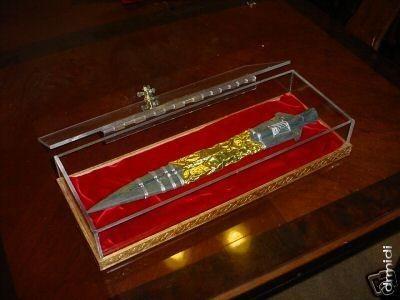Unsolved Mysteries of Spear of Destiny
Source : http://en.wikipedia.org/wiki/Holy_Lance
A spear with a mystical background gives the one wielding it powers to bend the destiny of the world to his or her will. It sounds like a Dungeons and Dragons campaign, but truth is far more bizarre in this case, as the legend of the Spear of Destiny contains a poison pill clause once the spear leaves the possession of a ruler, the individual dies within a matter of days. Kings and dictators sought out a legendary spear that pierced the heart of Jesus of Nazareth, deemed the Spear of Destiny, with several different artifacts laying claim to the name over the centuries. Are any of the relics real? Is there any hope that the authentic Spear of Destiny is floating around somewhere?
World shaping powers
The Spear of Destiny (also known as the Holy Lance) is a name given to the spear used by a Roman soldier to pierce the side of Jesus of Nazareth several hours into crucifixion.Raiders of the Lost Ark centers on Hitler’s predilection toward religious artifacts but his obsession with this particular item isn’t fictional. Historical records show that Hitler obtained the Spear of Destiny after annexing Austria in 1938, and brought the spear to St. Katherine’s Church in Nuremberg for safe keeping. Stories circle around Hitler’s fascination with the Spear of Destiny, which he first viewed as a young, nineteen-year-old painter in the Weltliches Schatzkammer Museum.
The Holy Lance (also known as the Spear of Destiny, Holy Spear, Lance of Longinus, Spear of Longinus or Spear of Christ) is the name given to the lance that pierced Jesus’s side as he hung on the cross in John’s account of the Crucifixion.
The Spear of Destiny, is in Christian tradition the spear that the Roman soldier Longinus thrust into the side of Jesus (c. 6 B.C.E.c. 30 C.E.) as he hung on the cross. (Then came the soldiers and brake the legs of the first and of the other which was crucified with him. But when they came to Jesus and saw that he was dead already, they brake not his legs: But one of the soldiers with a spear pierced his side and forthwith came out blood and water [John 19: 3234 KJV]).
Christian knights discovered the Holy Lance at Antioch during the First Crusade in 1098. The sight of the sacred artifact in the Church of St. Peter so inspired the beleaguered Christian soldiers that they rallied and routed the Saracens from the city. From that time forth, according to legend, whoever claims the spear and solves its secret holds the destiny of the world in his hands for good or evil. Although there are a number of relics in various European churches that claim to be the genuine Holy Lance, the spear that is on display in the Weltliches Schatzkammer Museum (the Hapsburg Treasure House Museum) in Vienna has been considered the most authentic and it has found a home there for 250 years. It is also known as Constantines Lance, and it was employed as a symbol of the imperial power of Holy Roman emperors at the time of their coronation in much a similar manner as the orb and scepter are used in the coronation of the monarchs of Great Britain.
According to Trevor Ravenscroft in The Spear of Destiny (1997), a 19-year-old Adolf Hitler (18891945) was first led to the lance in 1908 and from the moment of his first encounter with it in the museum, it became the central pivot in his life and the very source of his ambitions to conquer the world. In addition to Constantine (d. 337), Hitler found that as many as 45 emperors had owned the lance before the great Charlemagne (742814) had possessed it. Frederick the Great of Germany (11941250), who founded the Teutonic Knights on which Hitler allegedly based his SS, had also been an owner of the Spear of Destiny at one time. Ravenscroft claimed in his book that Hitler would often visit the museum, stare at the Holy Lance, and enter into a trance state in which he would view his future glory as the master of the Third Reich.
Thirty years later, on March 14, 1938, Hitler arrived in Vienna to oversee the annexation of Austria. He also observed the transfer of the Hapsburg Crown Jewel collection, which included the Holy Lance, from Vienna to Nuremberg, the Nazis favorite city. With the Spear of Destiny now safely ensconced in Germany, Hitler declared that the war could begin in earnest. The lance would be well protected in the hall of St. Katherines Church, where it had once rested for nearly 400 years. However, later in the war when Allied bombers damaged a portion of St. Katherines, the many treasures looted by the Nazis and stored there were taken to another hiding place. In the chaos and confusion, the Holy Lance was inadvertently left behind.
The Spear of Destiny fell into the hands of U.S. soldiers on April 30, 1945. A few hours after the Holy Lance passed from Nazi possession on to its next claimant to world power, Adolf Hitler committed suicide in his Berlin bunker. Later, the United States officially returned the Holy Lance to Austria, alongwith the other treasures that the Nazis had stolen. Today, the Spear of Destiny stands again in the Hapsburg Treasure House Museum in Vienna.
The Power of the Spear
Everyone knows that Jesus was pierced in the side with a Spear of some sort. It is usually assumed that it was just an ordinary Roman soldier’s spear that just happened to be available at the time. Later, it passes into many hands, arriving–supposedly–into Hitler’s possession at the start of the Second World War. Near the end of that war, the story goes, General Patton discovers the Spear in a bunker under Nuremberg, realizes what it is, and at that very moment, Hitler commits suicide and the U.S. succeeds Germany as the new World Power…because it now holds the Spear.
That Spear od Destiny has been kept in Vienna, Austria, where Hitler obtained it back in 1938, since shortly after the War. Is Austria now a World Power? It used to be–before the First World War, but no longer. But, of course, some people insist that Austria’s Hapsburg family secretly runs the world from behind their gilded walls in Vienna. Maybe. But not very effectively. The fact is, this may not be the true Spear. It could be one of several copies made at various times throughout the centuries.
The real Spear–if the legend of it always being in the possession of the current ruling World Power were true–ought to be in the United States, for the U.S. has emerged as the very greatest World Power in modern history. And what about Judea? The Spear was in Jerusalem for centuries and it
does not appear to have made the Jewish people dominant in the ancient world. In fact, they were overrun by just about every one of their neighbors. Come to think of it, Nazi Germany was also conquered when it had the Spear. So was Austria in 1938 and again when the Spear was returned
after the war. It may be that having this Spear is a way to get your nation conquered by its neighbors…
So is it possible the Spear has a different function than this notion of designating the current World Power? Is there a deeper, darker secret behind the Spear? Just where did it really come from? There are a myriad of questions swirling about this old relic, which has witnessed the whole pageant of our human history.
Various Relics Claimed to be the Holy Lance
There have been many relics that are claimed to be the Holy Lance, or parts of it.
Vatican Lance
No actual lance is known until the pilgrim Antoninus of Piacenza (AD/Crystalinks/Conspiracies html/speardestiny.html 570), describing the holy places of Jerusalem, says that he saw in the Basilica of Mount Zion “the crown of thorns with which Our Lord was crowned and the lance with which He was struck in the side”. A mention of the lance also occurs in the so-called Breviarius at the Church of the Holy Sepulchre. The presence in Jerusalem of this important relic is attested by Cassiodorus (c. 485 – c. 585) as well as by Gregory of Tours (c. 538 594), who had not actually been to Jerusalem.
In 615 Jerusalem and its relics were captured by the Persian forces of King Khosrau II (Chosroes II). According to the Chronicon Paschale, the point of the lance, which had been broken off, was given in the same year to Nicetas, who took it to Constantinople and deposited it in the church of Hagia Sophia, and later to the Church of the Virgin of the Pharos.
This point of the lance, which was now set in an icon, was sold in 1244 by Baldwin II of Constantinople to Louis IX of France, and it was enshrined with the Crown of Thorns in the Sainte Chapelle in Paris. During the French Revolution these relics were removed to the Bibliothèque Nationale but subsequently disappeared. (The present “Crown of Thorns” is a wreath of rushes.)
As for the larger portion of the lance, Arculpus claimed he saw it at the Church of the Holy Sepulchre around 670 in Jerusalem, but there is otherwise no mention of it after the sack in 615. Some claim that the larger relic had been conveyed to Constantinople sometime during the 8th century, possibly at the same time as the Crown of Thorns. At any rate, its presence at Constantinople seems to be clearly attested by various pilgrims, particularly Russians, and, though it was deposited in various churches in succession, it seems possible to trace it and distinguish it from the relic of the point. Sir John Mandeville declared in 1357 that he had seen the blade of the Holy Lance both at Paris and at Constantinople, and that the latter was a much larger relic than the former.
Whatever the Constantinople relic was, it fell into the hands of the Turks, and in 1492, under circumstances minutely described in Pastor’s History of the Popes, the Sultan Bayazid II sent it to Innocent VIII to encourage the pope to continue to keep his brother and rival Zizim (Cem) prisoner. At this time great doubts as to its authenticity were felt at Rome, as Johann Burchard records, because of the presence of other rival lances in Paris (the point that had been separated from the lance), Nuremberg (see “Vienna lance” below), and Armenia.
In the mid 1700s Benedict XIV states that he obtained from Paris an exact drawing of the point of the Spear od Destiny, and that in comparing it with the larger relic in St. Peter’s he was satisfied that the two had originally formed one blade. This relic has never since left Rome, where it is preserved under the dome of Saint Peter’s Basilica, although the Roman Catholic Church makes no claim as to its authenticity.
Echmiadzin Lance
The lance currently in Echmiadzin, Armenia, was discovered during the First Crusade. In 1098 the crusader Peter Bartholomew reported that he had a vision in which St. Andrew told him that the Holy Lance was buried in St. Peter’s Cathedral in Antioch. After much digging in the cathedral, a lance was discovered. This was considered a miracle by the crusaders who were able to rout the Muslim army besieging the city and decisively capture Antioch. Some Early Modern scholars (e.g. [[Odorico Raynaldi in Annales ecclesiastici and the Bollandists) believed that this lance afterwards fell into the hands of the Turks and was in fact the lance that Bayazid II sent to Pope Innocent and is now in the Vatican.
Vienna Lance (Hofburg spear)
The Holy Roman Emperors had a lance of their own, attested from the time of Otto I (912-973). In 1000 Otto III gave Boleslaw I of Poland a replica of the Lance at the Congress of Gniezno. In 1084 Henry IV had a silver band with the inscription “Nail of Our Lord” added to it. This was based on the belief that this was the lance of Constantine the Great which enshrined a nail used for the Crucifixion.
In 1273 it was first used in the coronation ceremony. Around 1350 Charles IV had a golden sleeve put over the silver one, inscribed “Lancea et clavus Domini” (Lance and nail of the Lord).
In 1424 Sigismund had a collection of relics, including the lance, moved from his capital in Prague to his birth place, Nuremberg, and decreed them to be kept there forever. This collection was called the Reichskleinodien or Imperial Regalia.
When the French Revolutionary army approached Nuremberg in the spring of 1796 the city councilors decided to remove the Reichskleinodien to Vienna for safe keeping. The collection was entrusted to one “Baron von Hügel”, who promised to return the objects as soon as peace had been restored and the safety of the collection assured.
However, the Holy Roman Empire was officially dissolved in 1806 and von Hügel took advantage of the confusion over who was the rightful owner and sold the entire collection, including the lance, to the Habsburgs. When the city councilors discovered this they asked for the Reichskleinodien back but were refused. As part of the imperial regalia it was kept in the Schatzkammer (Imperial Treasury) in Vienna and was known as the lance of Saint Maurice.
During the Anschluss, when Austria was annexed to Germany, Adolf Hitler took the lance. It was returned to Austria by American General George S. Patton after World War II and was temporarily stored in the Kunsthistorisches Museum. Currently the Spear is held in the Schatzkammer.
Dr. Robert Feather, an English metallurgist and technical engineering writer, tested the Spear od Destiny in January 2003.[8] He was given unprecedented permission not only to examine the lance in a laboratory environment, but was also allowed to remove the delicate bands of gold and silver that hold it together.
In the opinion of Feather and other academic experts, the likeliest date of the spearhead is the 7th century A.D. – only slightly earlier than the Museum’s own estimate. However, Dr. Feather also stated in the same documentary that an iron pin – long claimed to be a nail from the crucifixion, hammered into the blade and set off by tiny brass crosses – is “consistent” in length and shape with a 1st century A.D. Roman nail.
According to Paul the Deacon, the Lombard royal line bore the name of the Gungingi, which Karl Hauck and Stefano Gasparri maintain identified them with the name of Odin¹s lance, Gungnir (a sign that they probably claimed descent from Odin, as did most of the Germanic royal lines) Paul the Deacon also notes that the inauguration rite of a Lombard king consisted essentially of his grasping of a sacred/royal lance.
Milan, which had been the capital of the Western Roman Empire in the time of Constantine, was also the capital of the Lombard kings Perctarit and his son Cunipert, who became Catholic Christians in the 7th century. Thus it seems possible that the iron point of the Lombardic royal lance might have been recast in the 7th century in order to enshrine one of the 1st century Roman nails that St. Helena was reputed to have found at Calvary and brought to Milan, thus giving a new Christian sacred aura to the old pagan royal lance.
If Charlemagne¹s inauguration as the King of the Lombards in 774 had likewise included his grasping of this now-Christianized sacred or royal lance, this would explain how it would have eventually become the oldest item in the German imperial regalia. We might also note that the Iron Crown of Lombardy (dated to the 8th century), which eventually became the primary symbol of Lombardic kingship, takes its name from the tradition that it also contains one of the holy nails.
Alternately, since Gregory of Tours in his Libri Historiarum VII, 33, states that in 585 the Merovingian king Guntram designated his nephew Childebert II his heir by handing him his lance, it is possible that a royal Spear od Destiny was also a symbol of kingship among the Merovingian kings and that a nail from Calvary was in the 7th century incorporated into this royal lance and thus eventually would have come into the German imperial regalia.
Other Lances
Another lance has been preserved at Krakow, Poland, since at least the 1200s. However, German records indicate that it was a copy of the Vienna lance. Emperor Henry II had it made with a small sliver of the original lance. Another copy was given to the Hungarian king at the same time. The story told by William of Malmesbury of the giving of the Holy Lance to King Athelstan of England by Hugh Capet seems to be due to a misconception.



